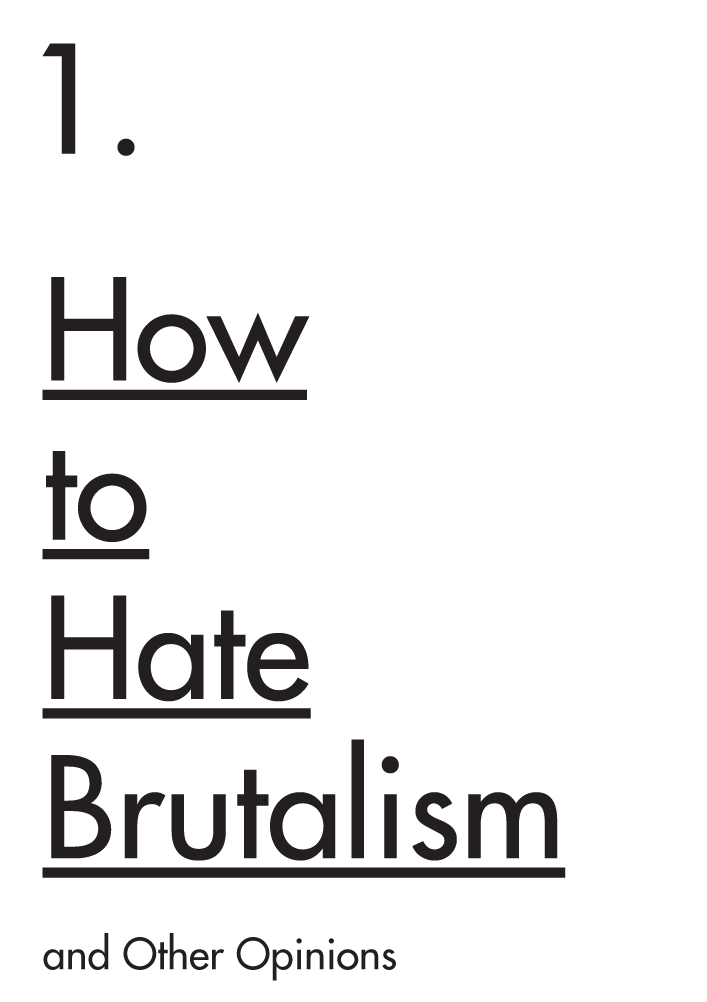
M ost of my friends and family don’t like brutalism. I sometimes wonder what they must think when a photo of yet another concrete edifice appears on my Facebook page, or hear my tales of exploring behind the scenes at the National Theatre. Yes, that sounds really interesting, John. Not that I fall instantly in love with every grey, rain-stained hulk I see. The first time I heard ‘Kiss’ by Prince I doubled over laughing at his squeaky voice, the barely there instrumentation and the absurdly forward lyrics. But by the third time, I was convinced it was the greatest song I’d ever heard. For me, learning to love buildings often follows a similar pattern. Some are immediately charming and loveable. With others it sometimes takes me a couple of goes to ‘get’ it. And they are often the ones I end up loving the most.
There are people who throw out the phrase ‘monstrous carbuncle’ in relation to modern architecture as readily as Harry Potter would throw a spell. For them exposed, unadorned concrete seems a threat. Perhaps they think their boldly expressed dismay can magically transform blocks of flats or city centres into half-timbered thatched cottages or picturesque villages. Certainly there have been stylistic movements – Neo-Vernacular or New Classicism, for example – that are eager to cosy up to these more conservative contemporary attitudes.
Opponents of brutalism often seem to think that the people who like it are kidding themselves. They think it’s intellectual posturing, a game played at the expense of the people who actually have to use these buildings every day. I am sure there are a few brutalistas to whom this applies, just as there are arch-ironists trumpeting everything from Baroque to mock Tudor. Accusations of elitism, what you might call let-them-eat-cakeism, hang over much discussion of modern architecture. They conjure up damaging images of thoughtless dilettantes condemning the poor and unfortunate to live in modernist housing estates, riddled with ‘concrete cancer’ and crime, places they wouldn’t themselves dream of living in. Yet that doesn’t explain why there are people queuing up to grab refurbished apartments in raw concrete masterpieces, such as London’s Balfron Tower or Keeling House. Even if there are people who evidently like the buildings, this in turn throws up disturbing visions, of class cleansing and the privatization of council housing. Behind both scenarios, intellectual elitists or incoming apartment-dwellers, lie the real lives of those who have lived in brutalist flats since they were built. Their voices are usually ignored and selectively edited out of histories of the era. It is undeniable that many thousands of people were delighted to leave overcrowded, insanitary Industrial Revolution slums, and loved their new brutalist homes.
In the wake of the terrible Grenfell Tower fire of 2017, the reality of modern life in what remains of post-war social housing in Britain has been exposed. There are arms length management bodies, complex contracts for maintenance and refurbishment and decisions made over the wishes of the residents. They have combined to make many in social housing feel as powerless and exploited as the inhabitants of the 19th century-slums these buildings had been constructed to replace. These are not the fault of the buildings, but this political and market-led undermining of mass housing affects the lives of millions.
There have long been political reasons to undermine brutalism. These go back to the 1970s, and to the rise of free market economics that sought to sweep aside the post-war welfare states across Europe. Brutalism was one of the modern forms of architecture that came to be associated with the rise of council housing after World War II, and so it came under decades of sustained ideological attack by free marketeers in both government and the media. We are still seeing the results of this now, with council houses sold off in Britain and the remaining defunded social housing blocks blighted by maintenance and social problems, dismissed as a failure and demolished to make way for expensive private housing. The Grenfell Tower fire has to be seen against a political backdrop where regulations that might have helped save the lives of its overwhelmingly working-class tenants have been stifled. Criticism of brutalism is often tinged with class hatred, a desire for gentrification and a ‘not in my back yard’ wish for these easy symbols of poverty or immigration to be swept away.
The more superficial criticism is that modern architecture is ugly. Pick your brutalist insult: drab grey shitholes, monstrous carbuncles, depressing to look at, grim and joyless, a festival of monotony, a concrete jungle. Such views seem prevalent in local authorities and management boards, often keen to defund modern buildings so as to hasten their failure and collapse. Perhaps they have an eye to replacing them with the kind of red brick invisibles or glass box unknowables that developers favour today.
The material, concrete, is the reason most people give for dismissing brutalist buildings. Let’s not mention that concrete appears in many of the most picturesque places in Britain – forming the piers and sea defences along our coast, or the steps through steep terrain – and is as ancient as the Romans. Perhaps behind this, these critics don’t hate concrete so much as they hate cities. While fine in a wild landscape, seen in a city this oddly primitive material created from much older particles is dismissed as brash and aggressively modern. Those of us that live in cities appreciate the joy of their diversity – of the people, the districts and the buildings themselves. As time passes, brutalism becomes integrated as part of our historic fabric. Like the dormant volcanoes that have created the dramatic landscape of Edinburgh, say, it is no longer a threat. The fear, however, is that brutalism is going extinct.